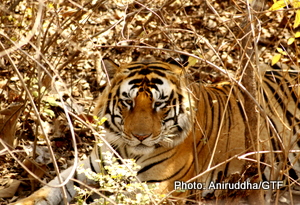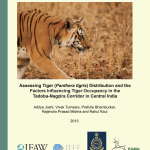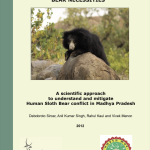Ten years of Indo-Russian Tiger Watch Programme
New Delhi, March 12, 2015: The Indo-Russian Tiger Watch Programme which was initiated in 2005 to motivate the Frontline Forest Inspectors of the Russian Federation, some of whom would even spent their lives without sighting a tiger in their country despite being deeply involved in the animal’s protection, achieved a milestone by clocking 10 years of its successful completion. This year’s orientation programme spread over 10 days, saw participation of two Inspectors from Russian Federation — Ivan Khobotnev and Sergei Roslovetc. As part of the programme, they were exposed to field experience on tiger conservation, coupled with in-house interactions with many Indian experts and managers involved in tiger conservation.
For practical knowledge, the delegation was taken to the Panna Tiger Reserve where they witnessed the different biological and sociological measures and impacts of tiger conservation in the area. Field Director of Panna, Rangaiah Sreenivasa Murthy, and his team shared with the visitors, the latest information on the tiger re-introduction in the reserve. The Russian delegation was visibly impressed with the success achieved on tiger re-introduction in Panna, which had, not very long ago, lost all its tigers. The population of tiger gradually has built from 0 to 30 at present.
A demonstration of various modern patrolling and monitoring techniques used for protection of tiger in Panna such as wireless communication system, radio-telemetry, camera traps and equipments used in wildlife rescue and rehabilitation, was made to the two Russian Inspectors.
Both the Inspectors were delighted to see a Bengal tiger in the wild for the first time in their lives, in the pristine habitat of Panna. Apart from tiger, they also saw many herbivores found in this reserve such as the spotted deer, chinkara, sambar, nilgai, wild boar and four-horned antelope, besides unique avifauna and vegetation of this nature reserve. They could also see the positive impact of village relocation in various sites in Panna especially inlands vacated due to relocation of Pipaltola village. The vacated lands are now restored as grasslands, presenting a heaven for both herbivores and carnivores. They could also see ‘magar’ crocodile basking on the banks of Ken River.
As part of their in-house orientation programme, they interacted with senior officers of the Wildlife Crime Control Bureau (WCCB), Global Tiger Forum (GTF), various senior experts and divisional Heads of Wildlife Trust of India, and learnt more about various conservation actions on tiger and other species in India, including differentiating seized wildlife body products from the fake ones. They also visited the National Zoological Park, Delhi, and got a first-hand feel of one of the important ex-situ conservation initiatives in India.
They also happened to get a taste of cultural heritage of India by visiting the world famous Temples of Khajuraho, and the Taj Mahal, Agra Fort, and Qutub Minar.
To sum up, the programme ended on a positive note with both the officers expressing great joy in being able to watch the Bengal tiger in the wild, and on being exposed to the modern monitoring techniques. In a formal interaction with Dr Jagdish Kishwan, Chief Policy Advisor, WTI, both of these inspectors mentioned, “The experiences and knowledge they gained through the field exposure and in-house interactions with managers will be communicated to their officers in Russia, and will, as far as possible, be also used in the field.”
Dr Kishwan expressing satisfaction on the successful completion of the Russians’ visit and added, “WTI would like to continue the programme maintaining its usefulness to the Russian colleagues by keeping the programme relevant by incorporating the latest advances in tiger management in India, in the Tiger Watch Programme.”












